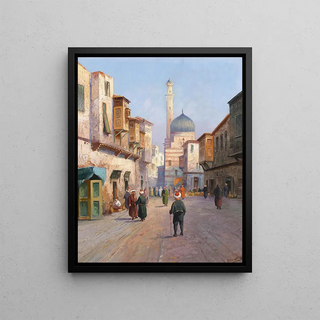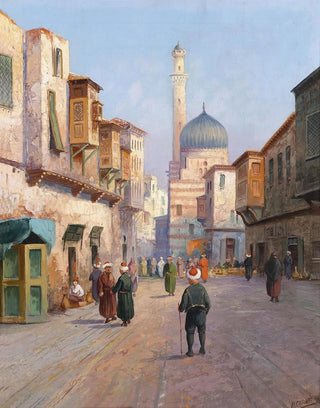Oriental Street Scene - Karl Kaufmann Art print


View from behind

Frame (optional)
In the captivating world of Orientalist art, the artwork "Oriental Street Scene" by Karl Kaufmann stands out for its enchanting atmosphere and meticulous details. This iconic piece transports the viewer to a world that is both mysterious and vibrant, where light plays a crucial role in highlighting architectural elements and characters. The scene captures a frozen moment in time, inviting meditative contemplation and a sensory journey through colors and textures. By immersing ourselves in this artwork, we discover not only the artist's technical skill but also an invitation to explore the cultures and landscapes that fascinated 19th-century artists so much.
Style and uniqueness of the artwork
Kaufmann's style in "Oriental Street Scene" is characterized by a keen attention to detail and a skillful use of light. The warm, earthy tones, typical of oriental landscapes, blend with delicate shadows, creating a depth that captivates the eye. The characters, dressed in traditional costumes, seem to be alive with their own vitality, each telling a story through their expression and gesture. The architectural elements, whether majestic arches or decorative motifs, reflect thorough research, paying homage to oriental aesthetics while adding a personal touch. This artwork is not merely a simple representation; it becomes an open window to a world where every detail deserves exploration.
The artist and his influence
Karl Kaufmann, a prominent figure in Orientalism, captured the essence of the cultures he depicted. His artistic training, influenced by the masters of his time, allowed him to develop a unique style that combines realism and romanticism. Traveling through Middle Eastern countries, Kaufmann was deeply influenced by the landscapes, traditions, and daily life of the populations he encountered. This immersion in other cultures fueled his imagination and enriched his work, making him a visual ambassador of the wonders of the Orient. His creations, including "Oriental Street Scene," continue to

Matte finish

View from behind

Frame (optional)
In the captivating world of Orientalist art, the artwork "Oriental Street Scene" by Karl Kaufmann stands out for its enchanting atmosphere and meticulous details. This iconic piece transports the viewer to a world that is both mysterious and vibrant, where light plays a crucial role in highlighting architectural elements and characters. The scene captures a frozen moment in time, inviting meditative contemplation and a sensory journey through colors and textures. By immersing ourselves in this artwork, we discover not only the artist's technical skill but also an invitation to explore the cultures and landscapes that fascinated 19th-century artists so much.
Style and uniqueness of the artwork
Kaufmann's style in "Oriental Street Scene" is characterized by a keen attention to detail and a skillful use of light. The warm, earthy tones, typical of oriental landscapes, blend with delicate shadows, creating a depth that captivates the eye. The characters, dressed in traditional costumes, seem to be alive with their own vitality, each telling a story through their expression and gesture. The architectural elements, whether majestic arches or decorative motifs, reflect thorough research, paying homage to oriental aesthetics while adding a personal touch. This artwork is not merely a simple representation; it becomes an open window to a world where every detail deserves exploration.
The artist and his influence
Karl Kaufmann, a prominent figure in Orientalism, captured the essence of the cultures he depicted. His artistic training, influenced by the masters of his time, allowed him to develop a unique style that combines realism and romanticism. Traveling through Middle Eastern countries, Kaufmann was deeply influenced by the landscapes, traditions, and daily life of the populations he encountered. This immersion in other cultures fueled his imagination and enriched his work, making him a visual ambassador of the wonders of the Orient. His creations, including "Oriental Street Scene," continue to






